by Dr. Gai Lindsay, and featuring “The Power of a Book” documentation by Gabriela Gomez de Torres and Denise Savins (Saigon Kids, Vietnam).
It brings me great joy to share this blog post with you. It honours the capacities of very young children to engage meaningfully in arts-focused projects of inquiry by sharing the documentation of a learning journey undertaken with two-year-old children at Saigon Kids Early Learning Centre in Saigon, Vietnam. Thanks to my wonderful friends and colleagues, Kieu An, Gabriella Gomez de Torres and Denise Savins. and to the children and families involved for allowing me to share their photos and documentation. I hope that in sharing this story early childhood professionals will be inspired to extend young children’s play and learning and to honour the interests and capabilities of children in meaningful and respectful ways.
My PhD research found that while early childhood educators frequently express the belief that children learn new skills through observation, exploration, modelling and collaboration, the transference of this sound pedagogical belief to their planning for visual arts experiences varied considerably. When it comes to planning arts experiences, many educators seem unsure about what might be possible, especially for very young children.

I frequently see evidence of this on social media platforms when educators ask questions such as:
- “What can I do as an easy art activity in the babies room?”…Or;
- “Any ideas for something I can make with the toddlers for Mother’s Day?”
Such posts on social media too often result in responses and suggestions for activities where “teachers’ minds and hands” are “central” and where the role children take in the process is “marginal” (Vecchi, 2010, p.132). As Vecchi warns, this choice leads “the same stereotyped products for all” (Vecchi, 2010. p. 132). At best, the suggestions offered list random possibilities for sensory experiences. At worst, the suggestions offered potentially lead to the types of experience where the child is relegated to the role of production line assistant for the educator to churn out adult-made templates constructed from children’s painting or hand prints. (See my previous blog about Christmas arts and crafts addressed the need to maintain a focus on the rights of children no matter the event or occasion that inspires the production of artwork with children.)
Planning visual arts experiences for young children
Planning visual arts learning experiences for younger children and babies requires that early childhood teachers and educators:
- Are aware of, and knowledgeable about, the languages and potentials of visual arts materials and processes;
- Value pedagogical processes that allow time for repeated encounters with materials (Vecchi, 2010);
- Embrace constructivist and sociocultural values to appreciate that learning is powerfully supported by moments of relatedness with others, with materials and within social environments (Cadwell, 1997);
- Believe in children’s readiness to learn, explore and communicate, no matter their age, ability or prior experience;
- Reject developmental assumptions that very young children are ‘not-yet-ready’ or ‘not-yet-able’ to engage with the full range of visual arts materials and processes;
- Reject the notion that young children require adult-intervention to help them to make products that will be finished or acceptable.
My research found a prevalence of unquestioned developmental justifications for close-ended, adult-constructed or embellished products amongst educators who were less confident in their own visual arts knowledge and confidence. Justification of pre-determined template activities were more commonly expressed by recently trained or less experienced educators. This highlights the need to increase visual arts coursework and offer professional development to build not only visual arts knowledge, but educator confidence regarding the application of visual arts methods in early childhood pedagogical contexts. Perhaps such limiting beliefs could be challenged by Malaguzzi’s statement that:
“To know children is to appreciate them and become more aware of our educational responsibility. However, before this it is right to sweep away once and for all the foolish belief that we must wait for a certain age in order to begin children’s education – ‘they don’t understand that anyway’. Children’s character and the personality of the child are constructed from birth, from the first days of life”
(1957, translated & cited in Cagliari et al., 2016, p. 54).
Meetings with materials
So, how can educators plan quality visual arts learning experiences for babies and toddlers or for children with additional needs or even for preschool children who have never encountered a new material or process? While it is helpful to be aware of children’s current developmental capacities – it is much more important to understand how to break down the elements of a learning experience to enable children to effectively engage with materials and processes no matter what their age, ability or experience with materials.
For example, think about the elements and processes of painting. What are the individual elements of painting? When you brainstorm the elements of the skill of painting you might identify potentials to plan for:
- Sensory meetings with paint such as finger-painting;
- Sensory meetings with paper and other textures involving opportunities to rip paper and to cut paper and to crawl through, under and inside paper;
- Experiences with different types of paint;
- Opportunities to develop the skill of using a paint brush. How to hold, lift, dip in paint, wipe brush, lift again and put on paper. What types of experiences could you plan for to build such skills with very young children? E.g Play put and take games, posting games, painting with water.
Material encounters are central to developing the range of visual, physical, vocabularies that, when combined, have the potential to support young children to express their ideas, theories, wonderings, delights and explorations through visual arts languages. Developing relationships and familiarity with materials and the elements of a skill or process establishes a culture of building and scaffolding of skills toward learning and growth (Lindsay, 2016). Click here to access my paper “Do visual art experiences in early childhood settings foster educative growth or stagnation?
The power of materials and art processes meet the power of books in the wonderful documentation story that follows. The documentation presented illustrates the way that responsive planning for young children and babies using the elements of a favorite story book and the languages of the arts opened up a “dynamic, interactive and collaborative” pedagogical process (French, 2013, p. 21). It also demonstrates how pedagogical processes where educators, artists and children engage with each other within socio-cultural encounters “should be underpinned by trust, love and care, reflection, mutual respect, and understanding (French, 2013, p.13).
Please enjoy reading the documentation in full along with a few final theoretical reflections that follow.
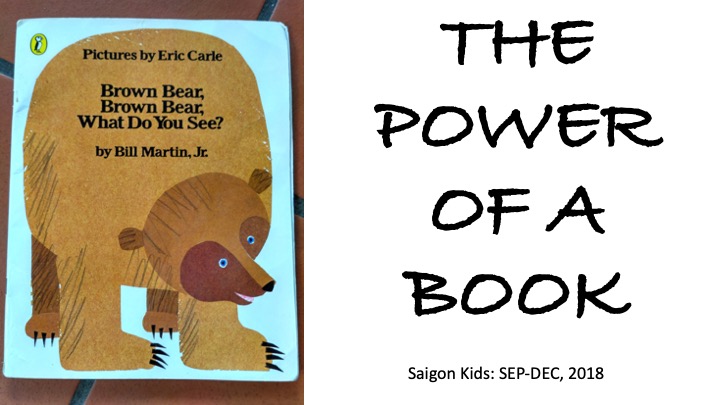
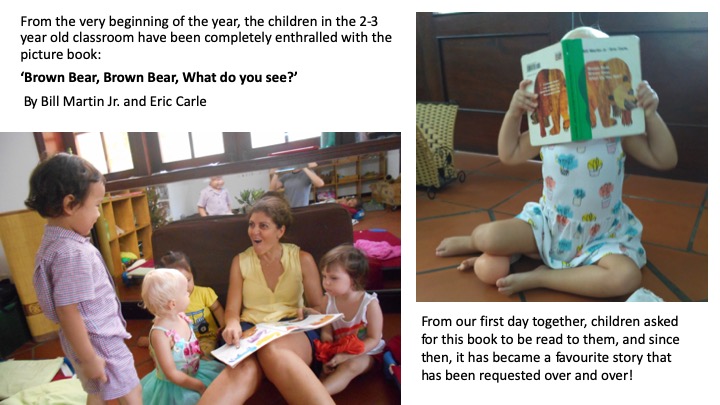



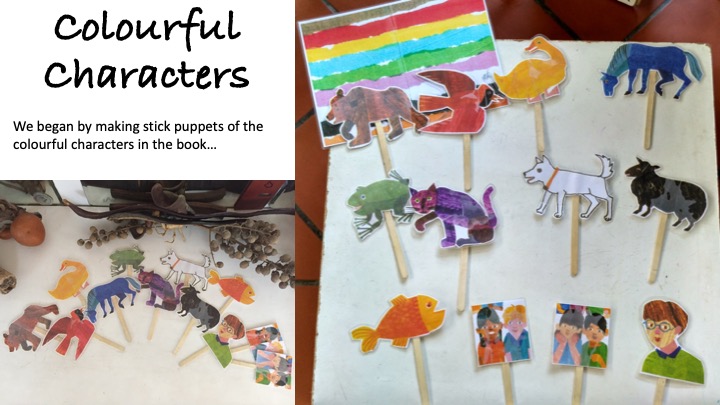
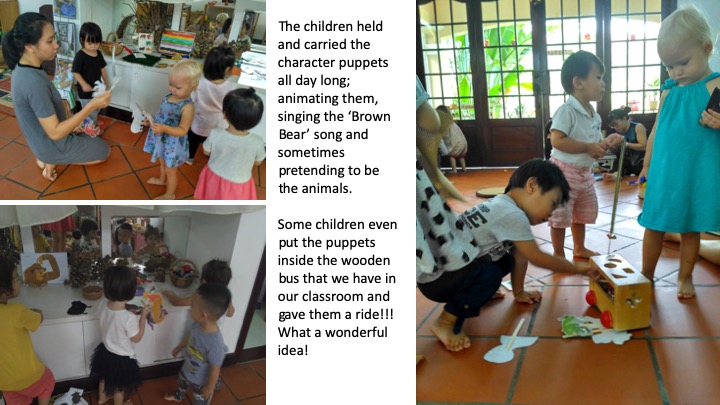



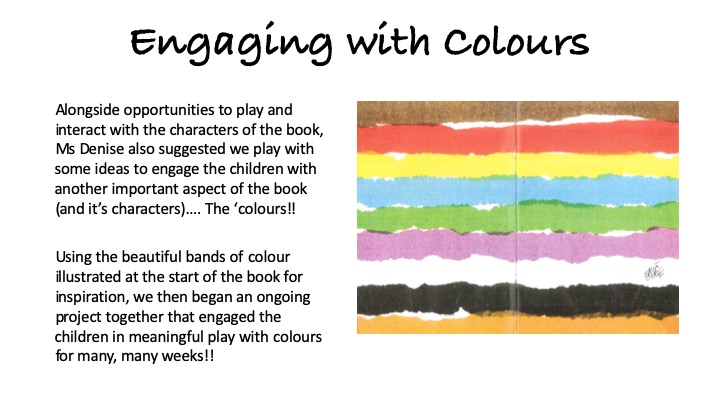

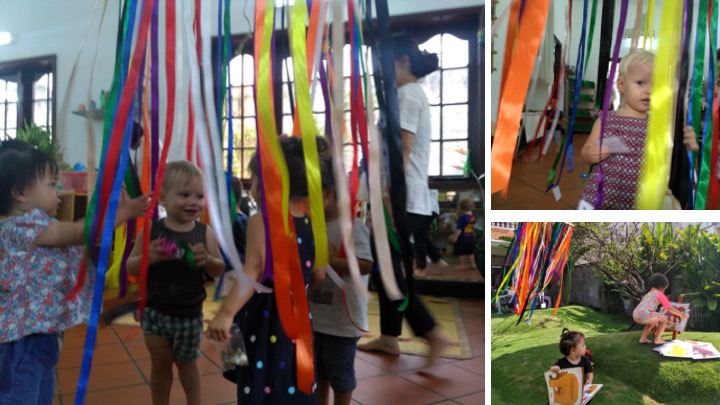


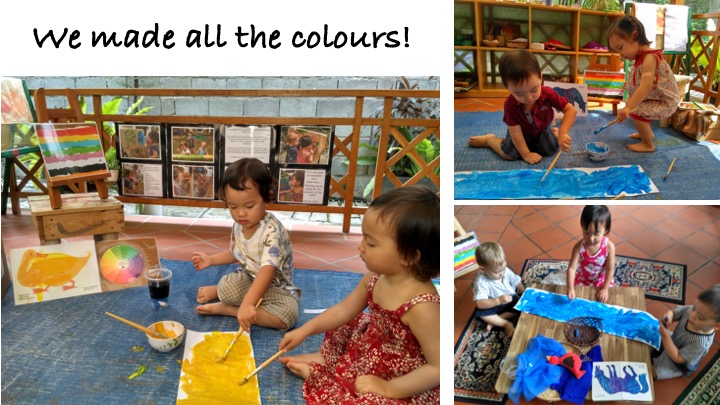


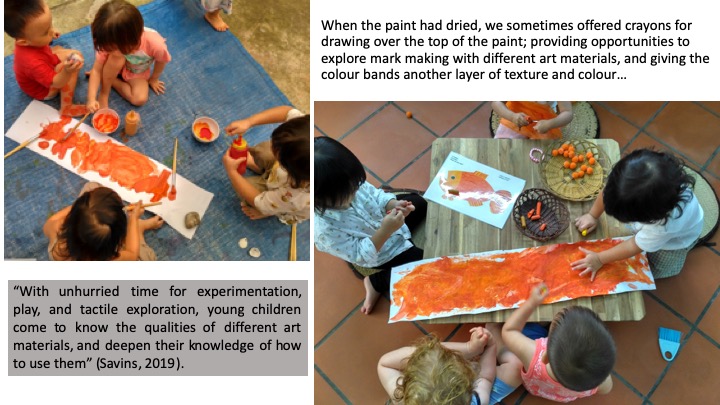

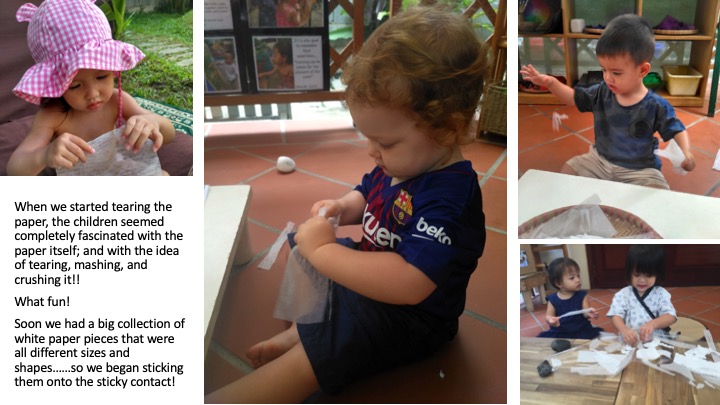
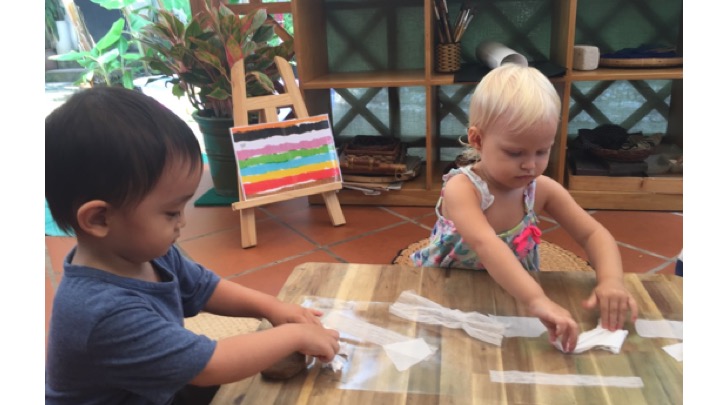
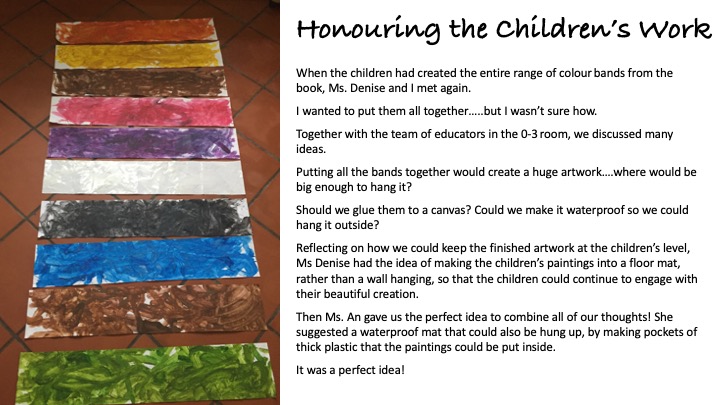

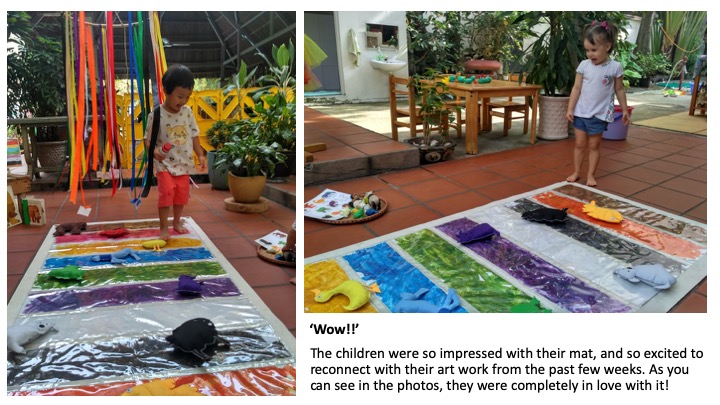
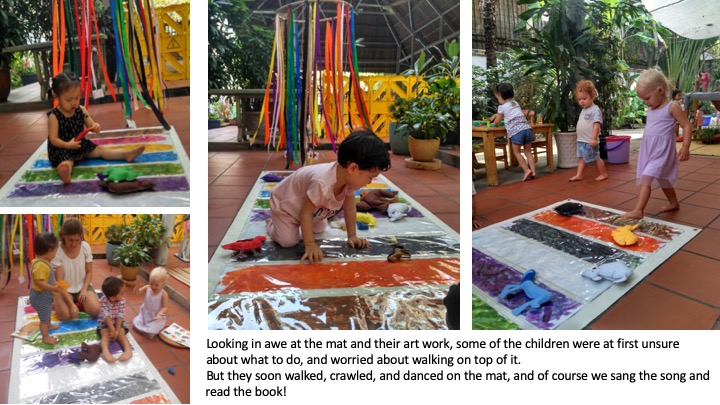
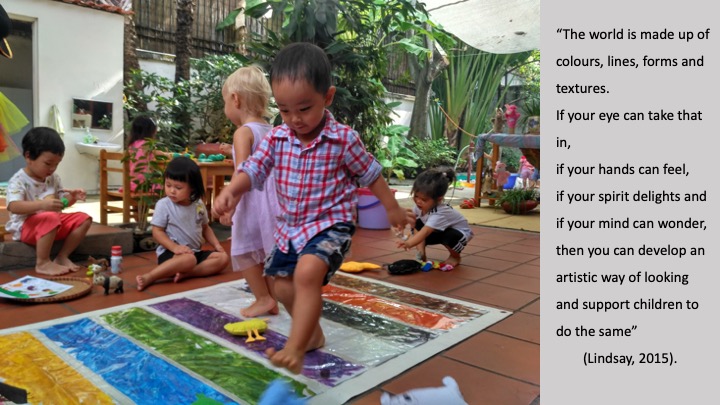

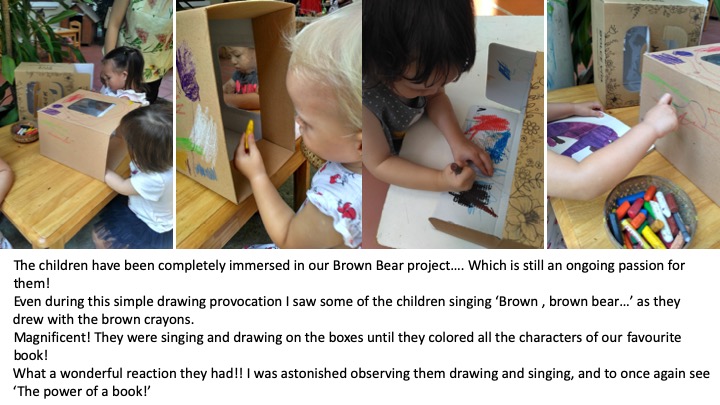
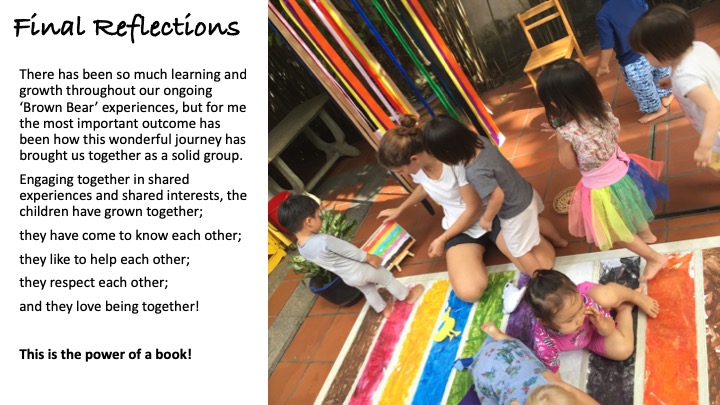
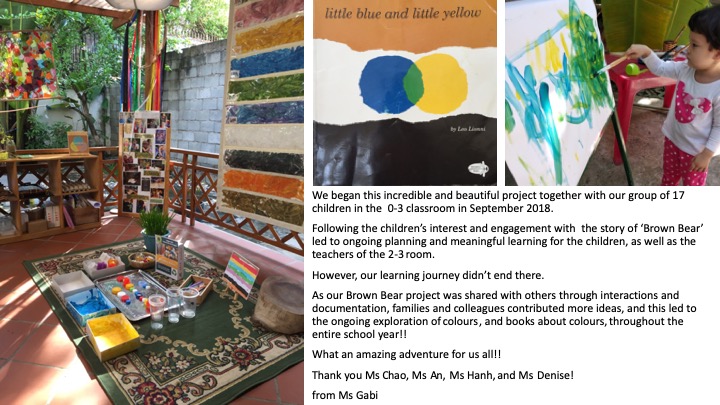

FINAL THOUGHTS
The work of the children and educators in the ‘Brown Bear’ project illustrates Dewey’s (1934) notion that in play, children powerfully experience true freedom through meaningful work. As Dewey (1934, p. 291) attests:
“No one has ever watched a child intent in his play without being made aware of the complete merging of playfulness with seriousness.”
The teachers and educators involved in this long-term project actively exercised their belief that children are capable, active protagonists who learn through hands-on experience with materials, the environment and collaborative inquiry with peers and educators (see Dewey, 1897, 1915; Malaguzzi, 1993, 1998; Tedeschi, 2012). In this project, the visual arts were positioned as a language.
Children, equipped with quality methods and materials, were supported to make, explore and communicate their interests, play preferences and explorations in relation to a favourite and well-loved book.
The teachers, in working collaboratively together, were empowered by the concept that as researchers of children’s learning processes and as co-leaners with children they did not have to always be the expert, but rather could utilise the visual arts to support meaningful learning experiences alongside the children and in collaboration with colleagues.
REFERENCES
Cadwell, L. (1997). Bringing Reggio Emilia Home: An Innovative Approach to Early Childhood Education. New York: Teachers College Press.
Cagliari, P., Castagnetti, M., Giudici, C., Rinaldi, C., Vecchi, V., & Moss, P. (Eds.). (2016). Loris Malaguzzi and the schools of Reggio Emilia: A selection of his writings and speeches, 1945-1993. Abingdon, Oxon: Routledge.
Dewey, J. (1897). My Pedagogic Creed. Washington, D.C The Progressive Education Association.
Dewey, J. (1915). The School and Society (2nd ed.). Chicago: The University of Chicago Press.
Dewey, J. (1934). Art as Experience. New York: Penguin Group (USA) Inc.
French, G. (2013). The Place of the Arts in Early Childhood Learning and Development. Commissioned paper from the Arts Council, Ireland, accessed from https://arrow.dit.ie/cgi/viewcontent.cgi?referer=https://au.search.yahoo.com/&httpsredir=1&article=1024&context=aaschsslrep
Lindsay, G. (2016). Do visual art experiences in early childhood settings foster educative growth or stagnation? International Art in Early Childhood Research Journal, 5(1), 1-14. http://artinearlychildhood.org/2016-research-journal-1/
Malaguzzi, L. (1993). For an Education Based on Relationships. Young Children, 49(1), 9-12.
Malaguzzi, L. (1998). History, Ideas, and Basic Philosophy: An interview with Lella Gandini. In S. Edwards, L. Gandini, & G. Forman (Eds.), The Hundred Languages of Children: The Reggio Emilia Approach – Advanced Reflections (pp. 49-97). Westport, Conneticut: Ablex Publishing.
Tedeschi, M. (2012). The Values of the Educational Experience in Reggio Emilia. Paper presented at the International Study Group: The Reggio Emilia Approach to education, Reggio Emilia, Italy.
Penfold, L. (2019). Material Matters in Children’s Creative Learning. Journal of Design and Science, (Issue 5), accessed from https://jods.mitpress.mit.edu/pub/bwp6cysy
Vecchi, V. (2010). Art and Creativity in Reggio Emilia: Exploring the role and potential of ateliers in early childhood education. London: Routledge.
I loved this opportunity for the children to further immerse themselves in the world of the book and the colours and the animals as they walked over and into the colours they had themselves created….so much to think about here…
LikeLike
Thanks Karen. Authentic meetings with materials and concepts is so respectful and extends children’s genuine delight withheld story and its characters.
LikeLike
Thank you this is a wonderful example of how to document the learning of the whole community.
LikeLike
Wow Gai this is wonderful. I love how these learning experiences have engaged the children in ongoing scaffolding of learning whilst also respecting the children’s art demonstrated by the way it has been recorded for ongoing interaction.
LikeLike
Hi Michelle. Thanks for your comment. Yes. It’s wonderful responsive and respectful work.
LikeLike
When my children were babies I read to them all the time. We did it together and enjoyed it. Jump ahead years later and while teaching high school, I used to read aloud to my high school classes. They would complain that they weren’t babies. I would tell them to sit back and enjoy. I had one class, five kids because I was a special ed teacher, who ended up loving short stories by Roald Dahl! I bet if I saw them today they could retell Lamb to the Slaughter word by word! It is so important at every age!
LikeLike
I so agree. Story telling and reading are so important. I read a couple of Roald Dhal books in my children’s classrooms in year 2 as my parent help contributions. Magical times. X
LikeLiked by 1 person